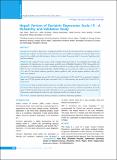Please use this identifier to cite or link to this item:
https://hdl.handle.net/20.500.14356/1355Full metadata record
| DC Field | Value | Language |
|---|---|---|
| dc.contributor.author | Risal, Ajay | - |
| dc.contributor.author | Giri, Eliza | - |
| dc.contributor.author | Shrestha, Oshin | - |
| dc.contributor.author | Manandhar, Sabina Manandhar | - |
| dc.contributor.author | Kunwar, Dipak | - |
| dc.contributor.author | Amatya, Richa | - |
| dc.contributor.author | Manandhar, Nirmala | - |
| dc.contributor.author | Manandhar, Kedar | - |
| dc.contributor.author | Holen, Are | - |
| dc.date.accessioned | 2023-05-08T10:02:46Z | - |
| dc.date.available | 2023-05-08T10:02:46Z | - |
| dc.date.issued | 2019 | - |
| dc.identifier.citation | RisalA., GiriE., ShresthaO., ManandharS., KunwarD., AmatyaR., ManandharN., ManandharK., & HolenA. (2020). Nepali Version of Geriatric Depression Scale-15 – A Reliability and Validation Study. Journal of Nepal Health Research Council, 17(4), 506-511. https://doi.org/10.33314/jnhrc.v17i4.1984 | en_US |
| dc.identifier.issn | Print ISSN: 1727-5482; Online ISSN: 1999-6217 | - |
| dc.identifier.uri | http://103.69.126.140:8080/handle/20.500.14356/1355 | - |
| dc.description | Original Article | en_US |
| dc.description.abstract | Abstract Background: Geriatric depression is a significant problem in both the developed and the developing world. To identify this condition, Geriatric Depression Scale has been used in different languages and cultural settings; it has proved to be a reliable and valid instrument. However, the Geriatric Depression Scale-15 version in Nepali has so far not been validated. Methods: The original 15-item version of the Geriatric Depression Scale-15 was translated into Nepali and administered by trained nurses to a target sample aged ?60 years at Dhulikhel Hospital (n=106). Subsequently, the participants were blindly interviewed by a consultant psychiatrist for possible geriatric depression according to the ICD-10 criteria. Cronbach’s alpha checked the reliability. Validity was assessed for three different cut-off points (4/5, 5/6, and 6/7); the related sensitivity, specificity, positive predictive value, and the negative predictive value of the scale were estimated. Results: The mean participant age was 68.1 (±7.2); males and females, 50.9% and 49.1%, respectively. Cronbach’s alpha was 0.79.The optimal cut-off point was found to be 5/6 with sensitivity and specificity 86.3% and 74.5%, respectively. Conclusions: Using a standard statistical protocol, a reliable and valid Geriatric Depression Scale-15-Nepali was developed with an adequate internal consistency and an optimal balance between sensitivity and specificity at cut-off point 5/6.The Geriatric Depression Scale-15-Nepali can serve as an appropriate instrument for assessing geriatric depression in epidemiological research as well as in primary health care settings in Nepal. Keywords: Geriatric depression; internal consistency; sensitivity; South Asia; specificity. | en_US |
| dc.language.iso | en | en_US |
| dc.publisher | Nepal Health Research Council | en_US |
| dc.relation.ispartofseries | Oct-Dec, 2019;1984 | - |
| dc.subject | Geriatric depression | en_US |
| dc.subject | Internal consistency | en_US |
| dc.subject | Sensitivity | en_US |
| dc.subject | South Asia | en_US |
| dc.subject | Specificity | en_US |
| dc.title | Nepali Version of Geriatric Depression Scale-15 – A Reliability and Validation Study | en_US |
| dc.type | Journal Article | en_US |
| local.journal.category | Original Article | - |
| Appears in Collections: | Vol. 17 No. 4 Issue 45 Oct-Dec 2019 | |
Files in This Item:
| File | Description | Size | Format | |
|---|---|---|---|---|
| 1984-Manuscript-13237-1-10-20200121.pdf | Fulltext Download | 914.18 kB | Adobe PDF |  View/Open |
Items in DSpace are protected by copyright, with all rights reserved, unless otherwise indicated.
